What was America’s role in the Holocaust?
Following its defeat in World War I and the punitive peace treaty the followed, Germany fell into a deep and extended economic depression. Nationalist leaders found a willing audience when they looked for scapegoats who could be blamed for the country’s troubles. Adolf Hitler’s National Socialist Party claimed that the Jewish people were traitors during the war and a blight on the nation. Hitler claimed that the Aryan race (northern Europeans) were genetically superior to all others and that the Jews were inferior. When he rose to power in the early 1930s, he began to impose punitive policies to punish and shame the Jews.
Extermination of the Jewish People
With the start of the war, Jews were rounded up and forced into work camps to make war supplies for their Nazi captors. They imposed similar policies on nations that they conquered, including France and eastern Europe. As the war progressed, the Nazis moved to even harsher measures until they reached the "ultimate solution" to the Jewish question: extermination of all Jews under their control. Concentration camps began the grisly process of killing Jews in massive numbers. Allied troops that began liberating these camps in 1945 were shocked at Nazi inhumanity, and German leaders responsible for giving such orders were tried and convicted in the Nuremburg Trials by international courts for their crimes.
While America knew about pre-war Nazi discrimination against the Jews, it did little to protest or demand an end to it. There was a heated debate in the nation about American involvement in or isolation from European disputes. The U.S. refused to expand its immigration policies to accept more Jews fleeing from Nazi persecution.
Anne Frank's Iowa Pen Pal
Iowa played a peripheral role in the debate on Nazi persecution. Some Iowans who traveled to Europe, including some Jewish Iowans, reported on disturbing trends in Germany. One connection stands out. In 1939, a teacher in the southeast Iowa town of Danville arranged for her students to select names pen pals. Margaret Wagner, 10, chose a girl her own age who lived in Amsterdam in the Netherlands. The girl’s name was Anne Frank. Margaret and Anne wrote several letters back and forth until Anne stopped writing. Margaret did not know why.
The reason was that Anne and her family had gone into hiding where they would stay for several years until they were discovered by the Nazis and sent to a concentration camp where Anne died. After the war, Anne Frank's diary written as the family was in hiding, was discovered and became one of the most famous documents in the Jewish experience under Nazi oppression. Today, a museum in Danville, The Anne Frank Connection, tells the story of the two girls. Their letters are on display, one of the two places in the world where visitors can see the correspondence itself.
In 2013, there was a groundbreaking for the Iowa Holocaust Memorial on the grounds of the Iowa Capitol. Today, it stands as a grim reminder of the Nazi genocide and a memorial to those who suffered it.
Supporting Questions
What was the Holocaust?
- Telegram from Sir G. Ogilvie Forbes about "Kristallnacht," November 10, 1938 (Document)
- Telegram from Gerhart Riegner to S.S. Silverman about Jewish Extermination in Concentration Camps, August 10, 1942 (Document)
- Letter to British Labour Leader Clement Attlee about Jewish Persecution from the "Central Leadership" Group in Poland, Date Unknown (Document)
- Illustration of European Refugees in Germany during World War II, 1945 (Image)
- German People of Nordhausen Digging Mass Graves for Concentration Camp Victims, April 1945 (Image)
- Unidentified German Concentration Camp Liberated by the U.S. Army, April 20, 1945 (Image)
- Czech Survivor of a Nazi Concentration Camp in Flossenburg, Germany, May 4, 1945 (Image)
How did America respond to the Holocaust?
- Columnist Dorothy Thompson Urges Congress to Help European Victims of the Nazis, April 22, 1939 (Image)
- "Murray Blasts Nazi Massacre of Jews" Newspaper Article, January 4, 1943 (Document)
- "Jaws of Death" - American Soldiers Landing in Normandy, France on D-Day, June 6, 1944 (Image)
- American Soldiers View Rows of Bodies at Lagar Nordhausen Concentration Camp in Germany, April 1945 (Image)
- Ernest Michael Bressler's Certificate of Naturalization, May 7, 1945 (Document)
- Telegram from Holocaust Refugee Steffy Bressler Asking about her Brother in Germany from Des Moines, Iowa, June 6, 1945 (Document)
- Letter from Holocaust Survivor Ingrid Mazie in Mason City, Iowa, to Her Grandmother in Europe, October 25, 1950 (Document)
- S.Res. 458, A Resolution from the U.S. Congress Recognizing Jewish American Heritage Month and Honoring Holocaust Survivors, May 22, 2014 (Document)
- Registration Letter for Helga Levy of Des Moines, Date Unknown (Document)
- Postcard Asking for Financial Assistance for Holocaust Survivors, Date Unknown (Document)
How has America responded to other genocides?
- Action Items for Assistant to the President for National Security Affairs' (APNSA) Trip to Rwanda, December 1994 (Document)
- Letter from U.S. President Bill Clinton to Burundi President Sylvestre Ntibantunganya, 15 January 1996 (Document)
- Sudanese Refugee Women and Children at Camp Mile in Chad, May 9, 2004 (Image)
- Sudanese Refugee Women and Children at Camp Tine in Chad, May 10, 2004 (Image)
- S.Res. 203 - A resolution by U.S. Congress Calling for China to Use Its Influence to Stop Genocide and Violence in Darfur, Sudan, May 16, 2007 (Document)
- S.Res. 455 - A Resolution by the U.S. Congress Calling for Peace in Darfur, March 5, 2008 (Document)
- "Waging Peace: Building a New Life in Chad after Conflict for the Victims of Darfur," January 12, 2009 (Video)
| Holocaust and America's Response to Other Genocides Source Set Teaching Guide |
| Printable Image and Document Guide |
S.Res. 203 - A resolution by U.S. Congress Calling for China to Use Its Influence to Stop Genocide and Violence in Darfur, Sudan, May 16, 2007
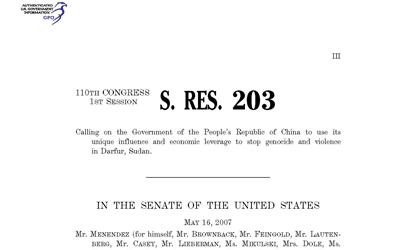
Description
This U.S. Senate resolution from 2007 called on the Chinese government to assist in stopping the genocide in Darfur, Sudan.
"Waging Peace: Building a New Life in Chad after Conflict for the Victims of Darfur," January 12, 2009
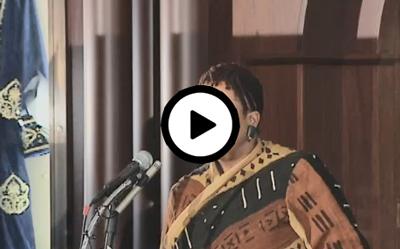
Description
This 36-minute-long video features Brian Wakley, chief executive of nongovernmental organization Cord, discussing "Waging Peace: Building a New Life in Chad After Conflict for the Victims of Darfur" in a program sponsored by the African and Middle Eastern Division. Cord is…
S.Res. 455 - A Resolution by the U.S. Congress Calling for Peace in Darfur, March 5, 2008

Description
A resolution passed in the Senate and called for peace in Darfur, Sudan. The resolution outlined the atrocities being faced by many Sudanese in the south and called for the government of Sudan to immediately stop all hostilities contributing to the Darfur genocide.
Telegram from Sir G. Ogilvie Forbes about "Kristallnacht," November 10, 1938
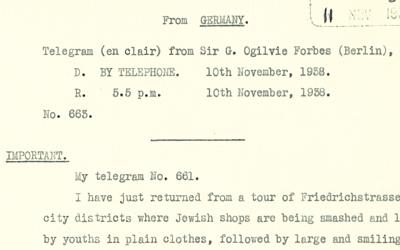
Description
This telegram was sent by Sir G. Ogilvie Forbes in Berlin, Germany, about the damage that occurred during Kristallnact to many Jewish properties. Kristallnacht, also known as the "Night of Broken Glass," refers to the violent anti-Jewish pogrom which took…
Telegram from Gerhart Riegner to S.S. Silverman about Jewish Extermination in Concentration Camps, August 10, 1942
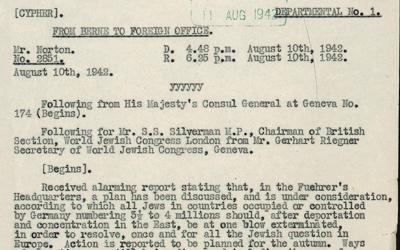
Description
This telegram, stored in the United Kingdom's National Archives, is from Gerhart Riegner to S.S. Silverman, both members of the World Jewish Congress. The focus of the telegram is about rumors that the Nazis are rounding up and deporting millions of Jewish people to…
Letter to British Labour Leader Clement Attlee about Jewish Persecution from the "Central Leadership" Group in Poland, Date Unknown
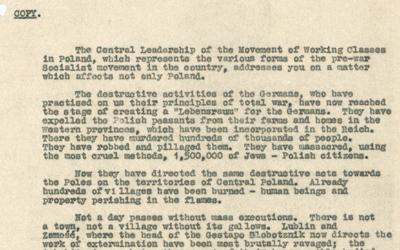
Description
This letter was sent from the Central Leadership of the Movement of Working Classes in Poland to the leader of the British Labour Party, Clement Attlee. The letter focuses on the ill-treatment of the Jewish people in Europe. Attlee would become prime minister of the…
Illustration of European Refugees in Germany during World War II, 1945
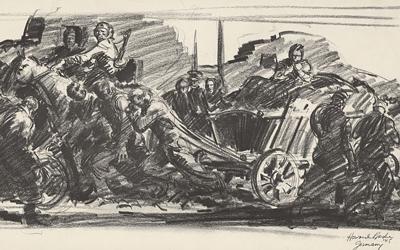
Description
This reproduction of a drawing by Howard Brodie shows European refugees pulling a large cart, bicycling and soldiers riding horses in one direction, as more soldiers walk in the opposite direction. The image is supposed to European refugees in Germany during…
German People of Nordhausen Digging Mass Graves for Concentration Camp Victims, April 1945
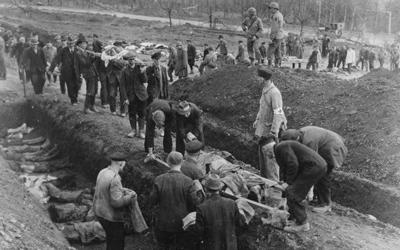
Description
This photograph shows residents of Nordhausen, Germany, digging mass graves for prisoners that were murdered in a concentration camp. The photo was taken April 1945 by a member of the U.S. Army, which liberated the camp.
Unidentified German Concentration Camp Liberated by the U.S. Army, April 20, 1945
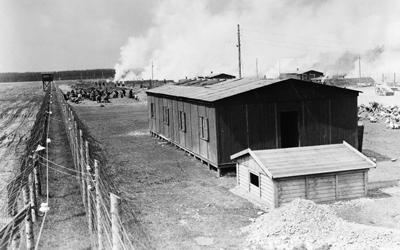
Description
This photograph captures an unidentified German concentration camp at the time of liberation by the U.S. Army on April 20, 1945. The photo shows a small building with barbed wire fencing around it. These camps, which were located all over German-occupied Europe,…
Czech Survivor of a Nazi Concentration Camp in Flossenburg, Germany, May 4, 1945
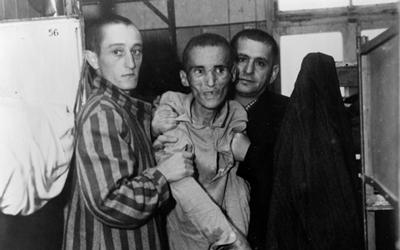
Description
This photograph shows an emaciated 23-year-old Czech man being held up by two other men. This young man was suffering from dysentery — an severe infection of the intestines — at a Nazi concentration camp in Flossenburg, Germany. He was found by the 97th Division of…
Columnist Dorothy Thompson Urges Congress to Help European Victims of the Nazis, April 22, 1939
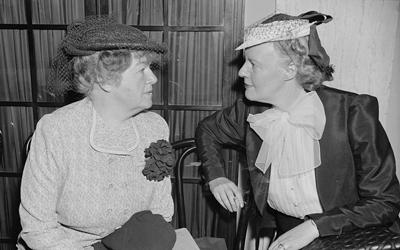
Description
American journalist and radio broadcaster Dorothy Thompson, right, is shown talking to U.S. Rep. Edith Nourse Rogers, left, after she testified before the Joint Congressional Committee on Immigration. Thompson, an influential female voice at the time,…
"Murray Blasts Nazi Massacre of Jews" Newspaper Article, January 4, 1943

Description
This newspaper article from CIO News highlights the atrocities of the Nazis on the Jewish people. The president of the labor union Congress of Industrial Organizations (CIO), Philip Murray, is quoted saying that the United States needs to "redouble our pledge of…
"Jaws of Death" - American Soldiers Landing in Normandy, France on D-Day, June 6, 1944
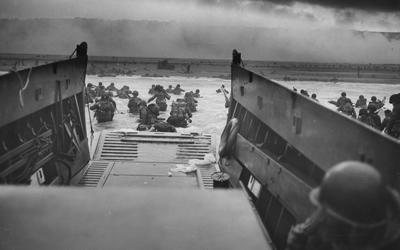
Description
This photograph from the Franklin D. Roosevelt Library in Hyde Park, New York, shows American soldiers landing in Normandy, France, on the morning of June 6, 1944, the beginning of the long-awaited invasion to liberate continental Europe from Nazi Germany. Most of the…
American Soldiers View Rows of Bodies at Lagar Nordhausen Concentration Camp in Germany, April 1945
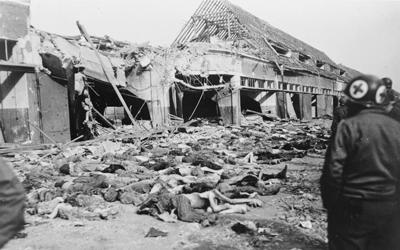
Description
This photograph shows a gratuitous scene at the Lagar Nordhausen Concentration Camp. American soldiers, who liberated the camp in 1945, are seen looking at the many bodies of prisoners that were murdered by the Nazis in the camp. Lagar Nordhausen was a sub-camp of…
Ernest Michael Bressler's Certificate of Naturalization, May 7, 1945
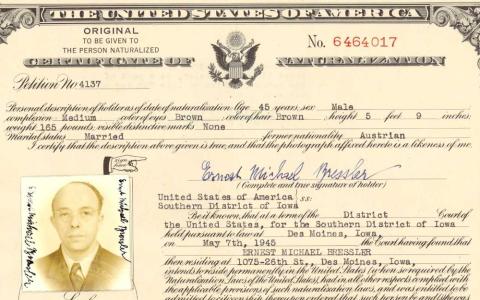
Description
This document is the certificate of naturalization for Ernest Michael Bressler, who is the husband of Steffy Bressler. The Austrian couple came to America to flee the Holocaust and were resettled in Des Moines. Both were able to…
Telegram from Holocaust Refugee Steffy Bressler Asking about her Brother in Germany from Des Moines, Iowa, June 6, 1945
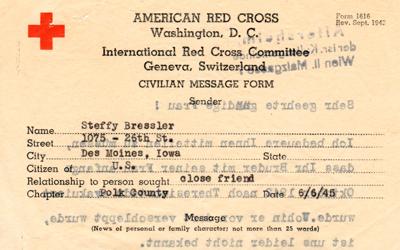
Description
This telegram through the American Red Cross was written by Steffy Bressler, a Jewish woman who escaped the Holocaust and resettled in Des Moines, Iowa. Bressler wrote Dr. Friedrich Willman seeking information on the whereabouts of her brother in Germany. The telegram was…
Letter from Holocaust Survivor Ingrid Mazie in Mason City, Iowa, to Her Grandmother in Europe, October 25, 1950
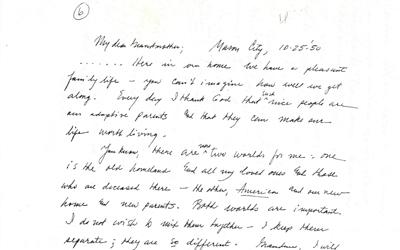
Description
Ingrid Mazie was a young survivor of the Holocaust; however, her parents did not survive. Ingrid went to New York as a refugee. She was adopted by a couple in Mason City, Iowa. Here she is writing a letter back home to her grandmother in Europe.
S.Res. 458, A Resolution from the U.S. Congress Recognizing Jewish American Heritage Month and Honoring Holocaust Survivors, May 22, 2014
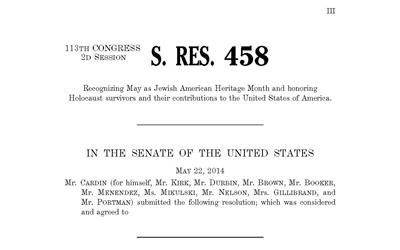
Description
This U.S. Senate resolution recognized May 2014 as Jewish American Heritage Month. The resolution also expressed appreciation for the contributions made to the United States by the survivors of the Holocaust and encouraged the people of the United States to learn…
Registration Letter for Helga Levy of Des Moines, Date Unknown
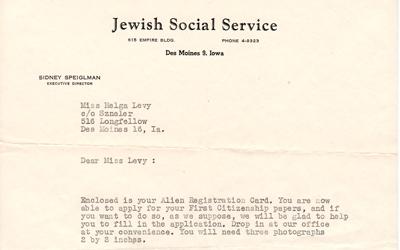
Description
This registration letter was for Helga Levy, a Holocaust survivor who resettled in Des Moines, Iowa. The registration letter also included her alien registration card. This documentation allowed her to apply for citizenship in the United States.
Postcard Asking for Financial Assistance for Holocaust Survivors, Date Unknown
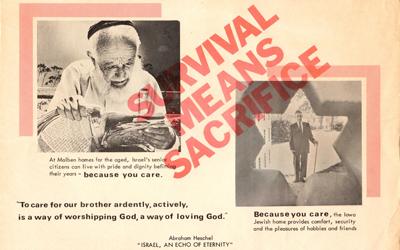
Description
This postcard was mailed to people in America asking for financial assistance or volunteers to help with aging Holocaust survivors. This postcard was addressed to "Mr. and Mrs. Marvin Mazie" in Des Moines, Iowa.
Action Items for Assistant to the President for National Security Affairs' (APNSA) Trip to Rwanda, December 1994

Description
This document is a list from the Clinton Administration of action items for the Assistant to the President for National Security Affairs (APNSA). This document was prepared for the APNSA to take to a meeting regarding the civil…
Letter from U.S. President Bill Clinton to Burundi President Sylvestre Ntibantunganya, 15 January 1996

Description
This letter was written to Burundi President Sylvestre Ntibantunganya from U.S. President Bill Clinton. In the letter, Clinton expresses concern about the violence in the country and promises to send Ambassador Madeline Albright to the country to stress the importance…
Sudanese Refugee Women and Children at Camp Mile in Chad, May 9, 2004
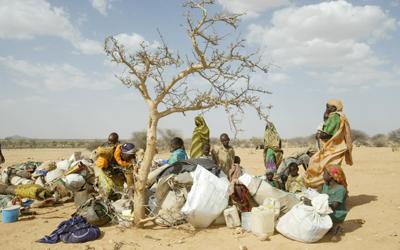
Description
This May 9, 2004, photograph taken by Konrad Fiedler, shows a group of Sudanese women and children refugees at Camp Mile, located in the country of Chad. The refugees had just received fresh rations. This camp opened four days before this photograph was taken to…
Sudanese Refugee Women and Children at Camp Tine in Chad, May 10, 2004

Description
This May 10, 2004, photograph taken by Konrad Fiedler, shows a Sudanese woman holding a baby, with a group of children and women behind her, at Tine Camp, a refugee camp in the country of Chad. According to Konrad Fiedler, "The Sudanese refugees of Camp Tine (…
Additional Resources
- United States Holocaust Memorial Museum
This is the main website for the U.S. Holocaust Memorial Museum, which is based in Washington, D.C. The website offers many online resources, such as major photo collections, research articles and online testimonials of Holocaust survivors. - The National Archives of the United Kingdom - Holocaust Exhibit
This website for the United Kingdom's National Archives includes primary sources related to the Holocaust. - Yad Vashem - The World Holocaust Remembrance Center
Yad Vashem is Israel's official memorial to the victims of the Holocaust. This is the memorial's official website, which includes large digital collections of photos, videos, etc., about the Holocaust, its victims and it survivors. - World Without Genocide
This website is based out of the Mitchell Hamlin School of Law and includes genocide-related educator materials.
Iowa Core Social Studies Standards (7th Grade)
Listed below are the Iowa Core Social Studies content anchor standards that are best reflected in this source set. The content standards applied to this set are high school-age level and encompass the key disciplines that make up social studies for seventh-grade students.
| No. | Standard Description |
| SS.7.13. | Identify social, political and economic factors that can influence our thoughts and behavior. |
| SS.7.15. | Distinguish and apply the powers and responsibilities of global citizens, interest groups and the media in a variety of governmental and nongovernmental contexts. (21st century skills) |
| SS.7.21. | Evaluate the push and pull factors involved in human population movement and patterns. |
| SS.7.24. | Analyze connections among historical events and developments in contemporary global issues. |
| SS.7.27. | Analyze the role that Iowa plays in contemporary global issues. |